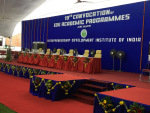Raj Shankar's Blog, page 4
October 29, 2018
A visit to Tromso to discuss Industry-Academia linkages
A couple of weeks ago I participated in a Design Thinking Lab activity at the University of Tromso (high up north in the Arctic), Norway. About 30 of us spent two hours thinking deeply about a challenge that is widely acknowledged — reducing the chasm between research (happening in Universities) and practice (happening within industries). The event was part of a research project to identify how to make this work.
[image error]All of us working together at the Design Thinking Lab. Photo Courtesy: Prof Rasmussen
The workshop was fun and facilitated by a pair of young entrepreneurs who run Design Thinking workshops for students and corporations. We sat in what they called, “The DTLab” – a space created for such activities.
The group was wonderful with two-thirds of the participants from industry and the remaining third from academia (of which I was a part). It was fun with a lot of productive outcomes. At the end it seemed to me that both sides (university and industry) were equally interested in closing this gap, and one of the biggest challenges was — lack of regular interactions to build solutions. Both sides agreed to implement at least one idea (of the many ideas we came up with). I am sure this will yield results.
When I first visited Bodo, I thought it was quite up north. But after I traveled further to Tromso, I realized I was pretty wrong! Some of my colleagues in the meeting actually traveled south for it 
September 29, 2018
Thirteenth Biennial Conference on Entrepreneurship
Happy to share that the 13th edition of the Biennial Conference on Entrepreneurship is scheduled to take place between 20 – 22 February 2019 at The Entrepreneurship Development Institute of India, Ahmedabad. I started attending the Biennial Conferences during its 10th edition and have been a regular since. It is probably the largest gathering of researchers, academicians, practitioners and policymakers in India. Apart from this the conference also hosts number of foreign delegates making it a truly international conference. The themes of the conference gives an idea of the breadth of topics you can see papers on. The last edition I remember we had close to 150 papers scheduled for presentation. [image error]
This year, the conference also has a dedicated conference website – http://conference.ediindia.org/ and here is the call for papers (abstracts due by 26th October 2018) – http://conference.ediindia.org/announcement/
Hope to see many of you, entrepreneurship enthusiasts, at the conference in Feb’19.
Note: Unfortunately the Biennial (and I) will miss Prof Dwijendra Tripathi in the coming edition. He who designed and set in motion the Biennial Conferences passed into history earlier this month. But all those who get together will make sure the conference lives up to the standards he set.
September 6, 2018
A historian passes into history
Obituary of Prof Dwijendra Tripathi
Getting up this morning to the news that a cherished teacher passed away was not a happy start. Prof Tripathi wrote the Oxford History of Indian Business, the Oxford History of Contemporary Indian Business and the Concise Oxford History of Indian Business among many others. He wrote one of the earliest articles on Indian Entrepreneurship in the Economic and Political Weekly. He probably held the first ever chair professorship on entrepreneurship in India, the Kasturbhai Lalbhai Chair Professor of Business History and Entrepreneurship at IIM Ahmedabad. He was instrumental in setting up The Journal of Entrepreneurship and the Biennial Conference on Entrepreneurship – both of which can easily be seen as visionary acts.
Beyond all his academic accomplishments, Prof Tripathi was a wise human being. I don’t [image error]think there was anyone who disliked him. Anyone who came in contact with him left improved by his wise counsel. I have been one of those lucky ones. I had the pleasure of meeting and interacting with him on many occasions. I particularly enjoyed my conversations with Prof Tripathi when I was writing an article building on his work. They helped me not only develop the article but also become a better human being.
History and him remained inseparable. As a historian passes into history, Prof Dwijendra Tripathi will be remembered fondly for a long time to come.
August 13, 2018
Accelerator Papers in AOM 2018
When I started my research in 2015 on accelerators, there were very few scholars [image error]working on it and hardly a handful of papers published on the phenomenon. In the Babson College Entrepreneurship Research Conference (BCERC) 2017 there were probably three papers on the topic. My BCERC 2017 presentation was received well and provided good feedback. My conference paper was developed and eventually published in the Journal of Business Venturing — you can read it here: Accelerating strategic fit or venture emergence: Different paths adopted by corporate accelerators
Hence I was quite excited when I saw a tweet from Susan Cohen (an early scholar on the topic) that there were 10 papers in this year’s Annual Meeting of the Academy of Management (AOM). Quite an increase in a short span of two years! In fact I was happy to see that there were 9 papers and one symposium too. The symposium will have 5 additional papers — thereby taking the total count of presentations on accelerators to 14. Here is the list of papers with links to them.
Link to Papers (nine in all)
Variance Decomposing of Accelerator and Cohort Effects Among London Startups — https://journals.aom.org/doi/10.5465/AMBPP.2018.80
Pace Yourself?: A Model of Varied Entrainment Responses in a Seed Accelerator — https://journals.aom.org/doi/abs/10.5465/AMBPP.2018.11158abstract
How inter-organizational relationships shape innovation in business accelerators — https://journals.aom.org/doi/abs/10.5465/AMBPP.2018.11488abstract
Entrepreneurial Acceleration: Exploring Accelerator Programs — https://journals.aom.org/doi/abs/10.5465/AMBPP.2018.12509abstract
Enhancing Human Capital with Social Capital via Entrepreneurial Learning in a Start-up Accelerator — https://journals.aom.org/doi/abs/10.5465/AMBPP.2018.12722abstract
High Growth, Innovation, and Business Accelerators:Differences Between Women- and Men-led Ventures — https://journals.aom.org/doi/abs/10.5465/AMBPP.2018.13720abstract
A Conceptual Examination Of Corporate Accelerators Versus Traditional Corporate Venturing Programs — https://journals.aom.org/doi/abs/10.5465/AMBPP.2018.14591abstract
The ‘Give and take’ of Mentorship Processes within Accelerators — https://journals.aom.org/doi/abs/10.5465/AMBPP.2018.15669abstract
Social Ventures, Impact Accelerators And Endorsement Signals: The Moderating Effect of Gender — https://journals.aom.org/doi/abs/10.5465/AMBPP.2018.16786abstract
Link to Symposium (with five presentations)
Business Accelerators and the Development of Early-Stage Ventures — https://journals.aom.org/doi/abs/10.5465/AMBPP.2018.17606symposium
I am not attending the AOM 2018. But I hope to hear and learn from friends who attend the AOM. Exciting times for people researching entrepreneurship support and entrepreneurial ecosystems.
July 3, 2018
My FPM Convocation
As shared earlier I defended my doctoral thesis in April 2018. On 30th June 2018 Entrepreneurship Development Institute of India (EDII) hosted the 19th Convocation of its Academic Programs. Happy to share that I participated in the convocation and received my “Fellow in Management” title. Incidentally I am EDII’s First Fellow.
Here are some photos from the event:







June 28, 2018
My First FT50 Publication
I am happy to share that my first FT50 journal publication just got online: https://www.sciencedirect.com/science/article/pii/S0883902617308376
My paper (co-authored with Dean A Shepherd) is published in The Journal of Business [image error]Venturing (popularly called JBV). JBV is widely accepted as the top entrepreneurship journal in the world. It is one of the top 50 journals in management too (an FT50 journal).
What is a FT50 journal? The Financial Times (FT) List of 50 Journals, popularly called “FT50” is considered the top journals in business and management. Publishing in them is considered prestigious. They are used to evaluate the research contributions while arriving at the top business school ranking. It is therefore not surprising that getting published in them is highly competitive and extremely rigorous. Here is a present list of the top 50 journals (FT50) – https://www.ft.com/content/3405a512-5cbb-11e1-8f1f-00144feabdc0
Hope to write more FT50s

May 20, 2018
At least we don’t ask “Should we?”
Business Plans are an important and highly debated artefact in entrepreneurship. Since I teach and research this subject, I get asked this very often. I am one who believes that “planning” is more important than “plans” and have advocated this to all my students. There are enough opinions for and against writing business plans, but I think this article caught my fancy. The main message is — don’t plan early; don’t plan for too long; and keep planning alongside other activities.
Link: https://hbr.org/2018/05/when-should-e...?
I liked this article for a few reasons:
It moves beyond the “should we?” debate
It is a research based work and not an opinion
It shows that it pays to plan
It shows the pros and cons of planning for entrepreneurs
I think entrepreneurs must read the article. More importantly I think entrepreneurship educators must read this article.
Hope you enjoy reading it.
May 16, 2018
Creating an innovative organisation
I am pretty curious about what makes certain organisations sustain an innovative culture while most others struggle and stagnate. This led to me to explore Corporate Innovation and Entrepreneurship as one of my research areas.
Since teaching is a good way to learn, I also teach topics around my research interests. One such new course is what I recently taught titled “Designing and Leading the Entrepreneurial Organisation” for the post graduate students of The Entrepreneurship Development Institute of India (EDII). Since the course refers to a lot about how to create and sustain entrepreneurialness within organisations, our discussions revolved around two problems — stopping bad habits (those that stop innovation) and cultivating new habits (ones that catalyse innovation)! While most courses discuss the latter, very few discuss the former. Without taking care of the former, the latter may not really work. Is that really why many new initiatives to sustain corporate innovation not result in results?
Though the course is formally over now, here are links to two articles that I would have (will use in the next edition of my course) shared with my students:
How to banish bad habits from your company? — Link: https://www.strategy-business.com/article/How-to-Banish-Bad-Habits-from-Your-Company
Creating a culture of innovation — Link: https://www.mckinsey.com/business-functions/strategy-and-corporate-finance/our-insights/creating-an-innovation-culture
While many of our readings are from journals and magazines, both my students and me keep sharing newer materials to supplement our learning. These also help us enhance the quality of our discussions inside and outside the classroom.
I thought it might be useful sharing it here so that we could hear from what you, the reader, thinks as well.
What according to you helps create an innovative organisation?
May 6, 2018
I am a Fellow in Entrepreneurship
What?
Thats what my friend asked me when I told him that!! 
April 5, 2018
Creating Great Choices
Title: Creating Great Choices – A Leader’s Guide to Integrative Thinking
Authors: Jennifer Riel and Roger L Martin[image error]
Life is spent making “Choices”, or at least we believe so. At times we do not make choices and wait until only one option is left in front of us At times we make compromised choices. Rarely people are able to make the much needed “trade-offs” between options. While “making trade-offs” is what makes choosing options difficult, Riel and Martin suggest in this book that there is a third possible way – a method to mix the best of two opposing options and thereby create a third option.
Integrative thinking was introduced by Roger Martin in an earlier work. He suggested that integrative thinking was a useful solution when the trade-offs to be made was painful to make. But his earlier work had given an impression that integrative thinking was an innate skill possessed by a few. Building on Martin’s earlier work on integrative thinking, the authors break this myth by providing a four-stage approach to practising integrative thinking. While the various stages are filled with subjective actions, the overall approach gives a sense of order to an otherwise art-like activity. Part one of the book also provides the theoretical background to the four-stage model being developed in the book. Briefly the authors review design thinking and behavioural decision-making. They also provide some key works that interested individuals can look up if they wish to learn more about these two subjects. They build a case for why three missing components (metacognition; empathy; creativity), if built, can help overcome the inherent limitations in our decision-making. These also are the basis for the four stage approach.
I am a big fan of Martin’s writing. I have reviewed, used and recommended his book “Playing to Win” innumerable people. I think this book does to thinking, what “Playing to Win” did for strategy. The book details the four-stage approach to integrative thinking:
articulating opposing models
examining the models
generating possibilities
assessing prototypes.
The second part of the book details the four stages with clear instructions on the sub-stages involved, tools required and practices to be followed. The book provides numerous templates for practicing the specific sub-stages. There are also number of suggested exercises under the “Try this” feature.
The book has numerous stories of individuals and organisations who have practiced integrative thinking. This gives both credence and inspiration for anyone to try using this approach in their lives. In an increasingly volatile, uncertain, complex and ambiguous world, when making trade-offs becomes painful, integrative thinking can be a handy solution.



